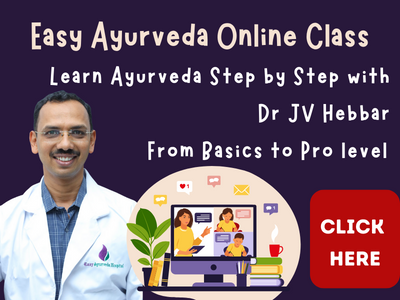The 20th chapter of Chikitsasthana of Sushruta Samhita is named as Kșudraroga Cikitsitam Adhyaya. This chapter deals with Treatment of Treatment of Minor Diseases.
अथातःक्षुद्ररोगचिकित्सितंव्याख्यास्यामः।।१।।
यथोवाचभगवान्धन्वन्तरिः।।२।।
We will now expound Kșudraroga Cikitsā — treatment of Minor Diseases; as revealed by the venerable Dhañvañtari.
Ajagallika
तत्राजगल्लिकामामांजलौकोभिरुपाचरेत्।।
शुक्तिश्रुघ्नीयवक्षारकल्कैश्चालेपयेद्भिषक्।।३।।
श्यामालाङ्गलकिपाठाकल्कैर्वाऽपिविचक्षणः।।
पक्वांव्रणविधानेनयथोक्तेनप्रसाधयेत्।।४।।
Firstly the unripe Ajagallika should be treated by bloodletting therapy done by applying leeches. The leeches would suck the vitiated blood.
After bloodletting, paste of the below mentioned ingredients should be applied –
– sukti (sea shell / oyster), srughni (svarjika ksara) and yava ksara or

– syama, langalaki and patha
The ripe form of Ajagallika should be provided with the treatment on the lines of treatment of Vrana (ulcer), as described already in chapter 1.
Añdhālaji etc.
अन्धालजीयवप्रख्यांपनसींकच्छपीतथा।।
पाषाणगर्दभंचैवपूर्वंस्वेदेनयोजयेत्।।५।।
मनःशिलातालकुष्ठदारुकल्कैःप्रलेपयेत्।।
परिपाकगतान्भित्त्वाव्रणवत्समुपाचरेत्।।६।।
Below mentioned are the common treatments for Añdhalajī, Yavaprahkhyā, Panasī, Kacchapī and Pāṣāņagardabha –
– firstly they should be given sudation (fomentation) and then

– paste of manaśśilā, tāla (haritāla), kuştha and devadāru should be applied
Once these conditions get ripened, they should be cut open and treated like vrana – wound.
Vivrta etc.
विवृतामिन्द्रवृद्धांचगर्दभीजालगर्दभम्।।
इरिवेल्लीगन्धनाम्नीकक्षाविस्फोटकांस्तथा।।७।।
पित्तजस्यविसर्पस्यक्रिययासाधयेद्भिषक्।।
रोपयेत्सर्पिषापक्वान्सिद्धेनमधुरौषधैः।।८।।
The below mentioned conditions should be treated on the lines of treating Pittaja Visarpa –
– Vivrta,
– Andhalaji,
– Gardabhi,
– Jalagardabha,
– Irivelli,
– Gandhanāma,
– Kaksa and
– Visphota
Ghee prepared from madhura aushadhas i.e. herbs predominantly having sweet taste should be used to bring about healing of the wounds.
Cippa – Kunakha
चिप्पमुष्णाम्बुनासिक्तमुत्कृत्यस्रावयेद्भिषक्।।
चक्रतैलेनचाभ्यज्यसर्जचूणेनचूर्णयेत्।।९।।
बन्धेनोपचरेच्चैनमशक्यंचाग्निनादहेत्।।
मधुरौषधसिद्धेनततस्तैलेनरोपयेत्।।१०।।
कुनखेविधिरप्येषकार्योहिभिषजाभवेत्।।
उपाचरेदनुशयींश्लेष्मविद्रधिवद्भिषक्।।११।।
Below mentioned are the steps in which Cippa should be treated –
– Cippa should be bathed with hot water following which
– the bad muscles should be excised and the pus and other contaminants in it should be drained out after which
– it should be anointed with Cakra Taila and then
– the powder of Sarja Ksara is put into the wound and it is bandaged, and
– cauterization (burning with fire) should be done if the above mentioned measures are not possible to do following which,
– it is made to heal with the oil prepared using herbs having sweet taste
The same treatments should also be used to treat Kunakha also.
Kunakha also should be given the same treatment.
The physician should treat Anusayi on the lines of treating Kaphaja Vidradhi.
Vidārikā
विदारिकांसमभ्यज्यस्विन्नांविम्लाप्यलेपयेत्।।
नगवृत्तिकवर्षाभूबिल्वमूलैःसुपेषितैः।।१२।।
व्रणभावगतायांवाकृत्वासंशोधनक्रियाम्।।
रोपणार्थहितंतैलंकषायमधुरैःशृतम्।।१३।।
प्रच्छानैर्वाजलौकोभिःस्राव्याऽपक्वाविदारिका।।
अजकर्णैःसपालाशमूलकल्कैःप्रलेपयेत्।।१४।।
पक्वांविदार्यशस्त्रेणपटोलपिचुमर्दयोः।।
कल्केनतिलयुक्तेनसर्पिमिश्रेणलेपयेत्।।१५।।
बद्ध्वाचक्षीरवृक्षस्यकषायैःखदिरस्यच।।
व्रणंप्रक्षालयेच्छुद्धांततस्तारोपयेत्पुनः।।१६।।
While treating Vidarika, it should first be anointed (snehana) followed by administration of fomentation (swedana).
Later it should be kneaded well and applied with the paste of the below mentioned ingredients macerated well –
– nāgavrttika (jiñginī or vrșcikäli),
– varsabhu and
– root of bilva
Once Vidarika becomes a wound, it should be cleaned. For cleaning the wound, oil prepared with herbs predominantly has astringent and sweet tastes.
Incision method or application of leeches should be used for taking out the blood (bloodletting) in case of unripe Vidarika.
Later, paste of Ajakarna and root of Palasa should be applied on it.
If the Vidarika is ripened, it should be cut open with a sharp instrument. After opening it, the paste of Patola, Picumarda and Tila mixed with ghee should be applied and bandaged.
Decoction of Ksiri Vrksa (Pancavalkala – trees yielding milky sap) and Khadira should be used to clean the wound and then the wound is made to heal.
Sarkarārbuda etc.
मेदोऽर्बुदविधानेनसाधयेच्छर्करार्बुदम्।।
कच्छूविचर्चिकांपामांकुष्ठवत्समुपाचरेत्।।१७।।
लेपश्चशस्यतेसिक्थशताह्वागौरसर्षपैः।।
वचादासिर्षपैर्वातैलंवानक्तमालजम्।।१८।।
सारतैलमथाभ्यङ्गेकुर्वीतकटुकैःशृतम्।।
Śarkarārbuda should be treated on the lines of treating Medoja Arbuda (as explained in chapter 11).
Kacchu, Vicarcika and Pama should be treated on the lines of treating Kustha (as explained in chapter 5).
Paste of the below mentioned should be used for application –
– Siktha (bee wax), Satahva and Gaura Sarsapa or
– Vaca, Darvi and Sarsapa
For anointing, oil of Nakramala should be used. Alternatively oil of Sala boiled with Katuka shall be used for the same purpose.
Pādadārī
पाददार्यांसिरांविद्ध्वास्वेदाभ्यङ्गौप्रयोजयेत्।।१९।।
मधूच्छिष्टवसामज्जसचूर्णघृतैःकृतः।।
यवाह्वगैरिकोन्मित्रैःपादलेपःप्रशस्यते।।२०।।
In Pādadāri, fomentation and anointing with oil (massage, external oleation) should be done at first followed by venepuncture.
Paste of the below mentioned ingredients added with ghee should be applied to the feet –
– madhūcista,
– vasā,
– majja,
– powder of sarjakşāra,
– yavāhva (yavaksāra) and
– gairika
This is considered as the best recipe for Padadari.
Alasa
पादौसिक्त्वाऽऽरनालेनलेपनंह्यलसेहितम्।।
कल्कीकृतैर्निम्बतिलकासीसालैःससैन्धवैः।।२१।।
लाक्षारसोऽभयावाऽपिकार्यस्याद्रक्तमोक्षणम्।।
सिद्धंरसेकण्टकार्यास्तैलंवासार्षपंहितम्।।२२।।
कासीसरोचनशिलाचूर्णैर्वाप्रतिसारणम्।।
Below mentioned measures should be done in the treatment of Alasa,
– Feet of the patient is washed with aranala i.e. fermented rice wash following which
– paste of nimba, tila, kāsīsa, āla, and saindhava or paste of läksärasa and abhayā is applied
– bloodletting should be done and
– oil prepared from Kantakari and Sarsapa is used and
– for filling the wound, powder of Kasisa, Gorocana and Sila (Manasila) is used
Kadara
उत्कृत्यदग्ध्वास्नेहेनजयेत्कदरसंज्ञकम्।।२३।।
Kadara should be removed using a sharp instrument (surgical removal). After its removal, the site should be burnt with hot oil.
Iñdralupta
इन्द्रलुप्तेसिरांमूलिस्निग्धस्विन्नस्यमोक्षयेत्।।
कल्कैःसमरिचैर्दिह्याच्छिलाकासीसतुत्थकैः।।२४।।
कुटन्नटदारुकल्कैर्लेपनंवाप्रशस्यते।।
प्रच्छयित्वाऽवगाढंवागुञ्जाकल्कैर्मुहुर्मुहुः।।२५।।
लेपयेदुपशान्त्यर्थंकुर्याद्वाऽपिरसायनम्।।
मालतीकरवीराग्निनक्तमालविपाचितम्।।२६।।
तैलमभ्यञ्जनेशस्तमिन्द्रलुप्तापहंपरम्।।
In Indralupta i.e. Alopacea areta, after anointing and providing fomentation, the vein of the scalp should be punctured.
After this, the skin should be mildly incised following which one of the below mentioned pastes should be applied –
– paste prepared from Marica, Manassila and Tutthaka or
– paste prepared from Kutannata and Devadaru
After doing a deep incision, the paste of Gunja may also be applied.
This condition should also be treated by adopting Rasayana.
Oil prepared with the below mentioned ingredients is the best one for anointing for the cure of indralupta –
– Malati,
– Karavira,
– Agni and
– Naktamala
Arūmşikā
अरूषिकांहृतेरक्तेसेचयेन्निम्बवारिणा।।२७।।
दिह्यात्सैन्धवयुक्तेनवाजिविष्ठारसेनतु।।
हरितालनिशानिम्बकल्कैर्वासपटोलजैः।।२८।।
यष्टीनीलोत्पलैरण्डमार्कवैर्वाप्रलेपयेत्।।
इन्द्रलुप्तापहंतैलमभ्यङ्गेचप्रशस्यते।।
In Arumsika, bloodletting should be done. Following this, the lesion should be washed with decoction of Nimbi.
Following this, fresh horse dung is collected and its juice extracted. The area of the lesion is smeared with this juice added with Saindhava, paste of Haritala, Nisa, Nimba and Patola.
Alternatively, paste of Yasti, Nilotpala, Eranda and Markava is applied
The oil mentioned above for the cure of Indralupta is also the best one for anointing in Arumsika too.
Darunaka
सिरांदारूणकेविद्धवास्निग्धस्विन्नस्यमूर्धनि।।२९।।
अवपीडंशिरोबस्तिमभ्यङ्गंचप्रयोजयेत्।।
क्षालनेकोद्रवतृणक्षारतोयंप्रशस्यते।।३०।।
In Dāruņaka, after anointing and providing fomentation to the head, the vein therein should be punctured.
After this, the below mentioned therapies should be done –
– avapida nasya – nasal drops,
– sirobasti – oil pooling over the head and
– abhyanga – massage with medicated oil
Decoction of the below mentioned should be used for washing the head –
– ash of kodrava,
– trna and
– ksara toya – solution of alkali / ash
Palita
उपरिष्टात्प्रवक्ष्यामिविधिपलितनाशनम्।।
Treatment of palita will be described later (in chapter 25).
Masurika
मसूरिकायांकुष्ठघ्नलेपनादिक्रियाहिता।।३१।।
पित्तश्लेष्मविसर्पोक्तिाक्रियावासंप्रशस्यते।।
In the treatment of Masurika, pastes which are explained to cure kustha (chapter 5) should be used.
Alternatively, treatments indicated for Slesma-Pitta Visarpa i.e. Erysipelas caused by combined aggravation of kapha and pitta (vide chapter 17) is considered to be the best for treating Masurika and hence should be used.
Jatumaņi, Maşaka and Tilakālaka
जतुमणिंसमुत्कृत्यमषकंतिलकालकम्।।३२।।
क्षारेणप्रदहेद्युक्त्यावह्निनावाशनैःशनैः।।
Treatment of Jatumani, Masaka and Tilakalaka includes excising and removing them. Later, the area should be often burnt either with ksara – caustic alkali or agni – fire.
Nyacca, Vyanga and Nilika
न्यच्छेव्यङ्गेसिरामोक्षोनीलिकायांचशस्यते।।३३।।
यथान्यायंयथाभ्यासंलालाट्यादिसिराव्यधः।।
घृष्टवादिह्यात्त्वचंपिष्टवाक्षीरिणांक्षीरसंयुताम्।।३४।।
बलातिबलयष्टयाह्वरजनीर्वाप्रलेपनम्।।
पयस्यागुरुकालीयलेपनंवासगैरिकम्।।२५।।
क्षौद्राज्ययुक्तयालिम्पेइंष्ट्रयाशूकरस्यच।।
कपित्थराजादनयोःकल्कंवाहितमुच्यते।।३६।।
In Nyaccha, Vyañga and Nīlika, the below mentioned treatments should be done –
It is best to conduct puncturing of vein in the forehead etc. as found suitable and convenient, after which
After vein puncture, the skin should be roughly rubbed.
Now pastes of the below mentioned may be applied over the lesion as found convenient and available –
- Paste of bark of trees yielding milk sap added with their own milk sap should be applied or
- Paste of the below mentioned should be applied –
– bala,
– atibala,
– yastyahva and
– rajani or
- Paste of the below mentioned ingredients should be applied –
– payasyā,
– aguru,
– kālīyaka and
– gairika
- Paste of a boar tusk (canine tooth) mixed with honey and ghee can be applied or
- Paste of kapittha and rājādana added with ghee and honey is beneficial
Yuvānapidaka
यौवनेपिडकास्वेषविशेषाच्छर्दनंहितम्।।
लेपनंचवचारोधसैन्धवैःसर्षपान्वितैः।।३७।।
कुस्तुम्बुरुवचालोध्रकुष्ठैर्वालेपनंहितम्।।
The same treatments are suitable for treating Yuvanapidaka. Mainly inducing vomiting will be needed.
Applying the paste prepared by the below mentioned ingredients is beneficial in treatment of Yuvanapidaka –
– Vaca,
– Rodhra,
– Saindhava and
– Sarsapa
Applicaiton of the paste of the below mentioned too is useful –
– Kustumburu,
– Vaca,
– Lodhra and
– Kustha
Padminikanțaka
पद्मिनीकण्टकेरोगेछर्दयेन्निम्बवारिणा।।३८।।
तेनैवसिद्धंसक्षौद्रंसर्पि:पानंप्रदापयेत्।।
निम्बारग्वधयोःकल्कोहितउत्सादनेभवेत्।।३९।।
Padminīkantaka should be treated in the below mentioned methods –
– Decoction of Nimba should be used to induce vomiting.
– For drinking purposes, ghee prepared with Nimba added with honey is the best.
– For massage, paste of Nimba and Aragvadha should be used.
Parivartika
परिवृत्तिंघृताभ्यक्तांसुस्विन्नामुपनाहयेत्।।
ततोऽभ्यज्यशनैश्चर्मचानयेत्पीडयेन्मणिम्।।४०।।
प्रविष्टेचमणौचर्मस्वेदयेदुपनाहनैः।।
त्रिरात्रंपञ्चरात्रंवावातघ्नःसाल्वणादिभिः।।४१।।
दद्याद्वातहरान्बस्तीन्स्निग्धान्यन्नानिभोजयेत्।।
Ghee should be used for anointing in Parivartika. After this, warm poultice should be tied.
Next, Parivartika should be once again anointed. The skin of the prepuce of penis should be pulled forward slowly and the glans penis is pushed in.
Warm poultice should be tied for three or five days after the glans penis has gone into the skin. Vata mitigating herbs or Salvana Upanaha should be used to prepare the poultice.
Enemas which mitigate Vata should be administered.
The patient is advised to consume foods which are unctuous.
Avapāțika
अवपाटिकांजयेदेवंयथादोषंचिकित्सकः।।४२।।
Similarly, the physician should treat Avapatika also in accordance with the aggravated dosha.
Niruddhaprakaśa
निरुद्धप्रकशेनाडीलौहीमुभयतोमुखीम्।।
दारवींवाजतुकृतांघृताभ्यक्तांप्रवेशयेत्।।४३।।
परिषेकेवसामज्जशिशुमारवराहयोः।।
चक्रतैलंतथायोज्यंवातघ्नद्रव्यसंयुतम्।।४४।।
त्र्यहाज्यहात्स्थूलतरांसम्यगाडीप्रवेशयेत्।।
स्रोतोविवर्धयेदेवंस्निग्धमन्नंचभोजयेत्।।४५।।
भित्त्वावासेवनींमुक्त्वासद्यःक्षतवदाचरेत्।।
In Niruddhaprakaśa a tube with opening at both ends should be taken. This tube should have been made from iron, wood or lac. This tube should be smeared with ghee and then introduced into the urethra.
The penis should be bathed with one of the below mentioned –
– fat or marrow of dolphin or boar or
– cakra taila boiled and prepared with vata mitigating herbs
To widen the urethral passage, a thicker tube should be inserted after every three days.
The patient is advised to take unctuous foods.
Alternatively, the raphae under the penis should be cut open and then treated like a wound.
Sanniruddhaguda, Valmīka and Agnirohiņī
सन्निरुद्धगुदंरोगंवल्मीकंवह्निरोहिणीम्।।४६।।
प्रत्याख्याययथायोगंचिकित्सितमथाचरेत्।।
विसर्पोक्तेनविधिनासाधयेदग्निरोहिणीम्।।४७।।
सन्निरुद्धगुदेयोज्यानिरुद्धप्रकशक्रिया।।
If the patient is suffering from diseases like sanniruddha guda, valmika and agnirohini, the incurability of these conditions should be intimated to the patient and his / her attendants and then treated.
Agnirohini should be treated on the lines of treating Visarpa (ch.17).
Likewise, Sanniruddha Guda should be treated on the lines of treating Niruddhaprakasha.
Valmika
शस्त्रेणोत्कृत्यवल्मीकंक्षाराग्निभ्यांप्रसाधयेत्।।४८।।
विधानेनार्बुदोक्तेनशोधयित्वाचरोपयेत्।।
वल्मीकंतुभवेद्यस्यनातिवृद्धममर्मजम्।।४९।।
तत्रसंशोधनंकृत्वाशोणितंमोक्षयेद्भिषक्।।
कुलत्थिकायामूलैश्चगुडूच्यालवणेनच।।५।।
आरेवतस्यमूलैश्चदन्तीमूलैस्तथैवच।।
श्यामामूलैःसपललैःसक्तुमित्रैःप्रलेपयेत्।।५१।।
सुस्निग्धैश्चसुखोष्णैश्चभिषक्तमुपनाहयेत्।।
पक्वंवातद्विजानीयाद्गतीःसर्वायथाक्रमम्।।५२।।
अभिज्ञायततश्छित्त्वाप्रदहेन्मतिमान्भिषक्।।
संशोध्यदुष्टमांसानिक्षारेणप्रतिसारयेत्।।५३।।
व्रणंविशुद्धंविज्ञायरोपयेन्मतिमान्भिषक्।।
सुमनाग्रन्थयश्चैवभल्लातकमनःशिले।।५४।।
कालानुसारीसूक्ष्मैलाचन्दनागुरुणीतथा।।
एतैःसिद्धंनिम्बतैलंवल्मीकेरोपणंहितम्।।५५।।
पाणिपादोपरिष्टात्तुछिद्रैर्बहुभिरावृतम्।।
वल्मीकंयत्सशोफंस्याद्वयंतत्तुविजानता।।५६।।
Valmīka should be excised (cut) with the help of a sharp instrument. Later, it should be cleared by applying ksara – caustic alkali or agni – fire. It should be done in the same manner as described in the treatment of arbuda in 18th chapter. Later it is made to heal.
Valmika with the below mentioned features should be cleansed well followed by bloodletting –
– that which has grown to very big size and
– that which is not situated on any marma – fatal spot
Paste of one of the below mentioned should be applied unctuous on the Valmika and warm poultice should be tied –
– root of kulathika and guduci added with saindhava lavana or
– root of arevata, root of danti and syama added with palala i.e. sesame paste and saktu (corn flour)
The intelligent physician should inspect the sinuses after it becomes ripe i.e. once pus is formed. Later he should cut them open with the help of a sharp instrument. He should cauterize it well many times, remove the vitiated muscles and clean it by applying ksara – alkalies.
The wise physician should make the wound heal after having noted that it has become clear.
Nimba Taila cooked and processed with the below mentioned ingredients is beneficial to heal Valmika –
– sumanā,
– grañthiparņi,
– bhallātaka,
– manaśśilā,
– kālānusāri,
– sūksmaila,
– candana and
– aguru
Valmika should be rejected when –
– it is situated on hands and feet,
– it has many sinuses of pus and
– it is associated with swelling / oedema
Ahipūtanā
धात्र्याःस्तन्यंशोधयित्वाबालेसाध्याऽहिपूतना।।
पटोलपत्रत्रिफलारसाञ्जनविपाचितम्।।
पीतंघृतंनाशयतिकृच्छ्रामप्यहिपूतनाम्।।
त्रिफलाकोलखदिरकषायंव्रणरोपणम्।।५८।।
कासीसरोचनातुत्थहरितालरसाञ्जनैः।।
लेपोऽम्लपिष्टोबदरीत्वग्वासैन्धवसंयुता।।५९।।
कपालतुत्थजंचूर्णंचूर्णकालेप्रयोजयेत्।।
Ahiputana is a condition which occurs in children. It should be treated after purifying the breast milk of the mother.
Ghee cooked with the below mentioned ingredients would cure even those cases of Ahiputana which are difficult to cure, when consumed –
– patolapatra,
– triphalā and
– rasāñjana
Decoction prepared with the below mentioned herbs would heal the wounds –
– triphala,
– kola and
– khadira
For application, below mentioned recipes should be used –
– Kāsīsa, gorocana, tuttha, haritāla and rasāñjana or
– Bark of badari added with saiñdhava – rock salt, macerated with any sour juice
At the stipulated time, powder of Kapala – potsherd and Tuttha should be sprinkled.
Muşka Kacchū
चिकित्सेन्मुष्ककच्छूचाप्यहिपूतनपामवत्।।६०।।
Muskak kacchū should be treated on the lines of treating ahipūtana and pāmā.
Gudabhramsa
गुदभ्रंशेगुदंस्विन्नंस्नेहाभ्यक्तंप्रवेशयेत्।।
कारयेद्गोफणाबन्धंमध्यच्छिद्रेणचर्मणा।।६१।।
विनिर्गमार्थंवायोश्चस्वेदयेच्चमुहुर्मुहुः।।
क्षीरेमहत्पञ्चमूलंमूषिकांचान्त्रवर्जिताम्।।६२।।
पक्त्वातस्मिन्पचेत्तैलंवातघ्नौषधसंयुतम्।।
गुदभ्रंशमिदंकृच्छूपानाभ्यङ्गात्प्रसाधयेत्।।६३।।
Gudabhramsa should be treated in the below mentioned ways –
– the prolapsed portion of rectum should be anointed with oils, fomentation administrated and slowly pushed in and then
– Gophana type of bandage should be tied, the bandage having hole in its center for expulsion of flatus and
– fomentation should be frequently given
– and Musika Taila should be used for drinking and anointing
Musika Taila – Musika means mice. The below mentioned ingredients should be boiled together and medicated oil is prepared using milk and decoction of vata mitigating herbs –
– Milk,
– herbs belonging to Mahat Pancamula group and
– Musika – mice, whose intestines have been removed
Benefits – This Musika Taila should be used for drinking and external application i.e. anointing. When done, it cures even those cases of Gudabhramsa which are difficult to cure.
इतिसुश्रुतसंहितायांचिकित्सास्थानेक्षुद्ररोगचिकित्सितंनामविंशोऽध्यायः।।२०।।
Thus ends the twentieth chapter by name Kșudraroga Chikitsa in Cikitsā Sthāna of Suśruta Samhita.

